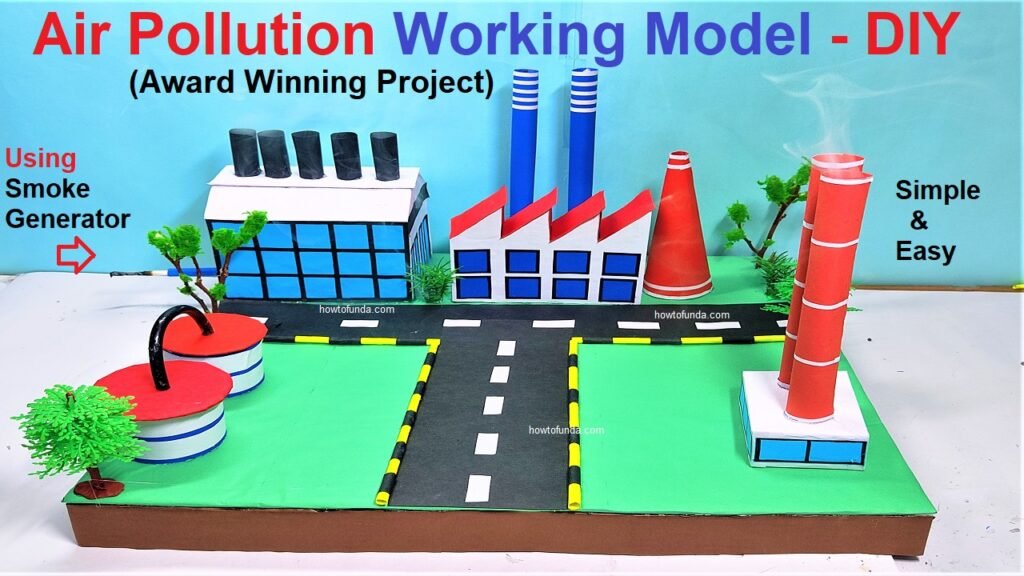Introduction
Air is one of the most essential components of life. It provides the oxygen that humans and animals need to survive and the carbon dioxide required by plants for photosynthesis.
However, in the present age of industrialization and urbanization, the quality of air is deteriorating at an alarming rate.

Air pollution has become a global issue that affects health, climate, and ecosystems.
It refers to the contamination of the atmosphere by harmful substances such as smoke, dust, gases, and chemical particles, which disturb the natural composition of air.
Definition of Air Pollution
Air pollution can be defined as the presence of one or more contaminants such as dust, fumes, gas, mist, odor, smoke, or vapor in the atmosphere in large quantities, for a duration that is harmful to human, animal, and plant life, or to property.
Causes of Air Pollution
Air pollution is caused by both natural and human-made factors. However, human activities are the primary contributors to today’s pollution problem.

- Industrial Emissions
Factories release large amounts of carbon monoxide, sulfur dioxide, nitrogen oxides, and hydrocarbons into the atmosphere. - Vehicular Emissions
The number of vehicles on roads has increased drastically, releasing toxic gases like carbon monoxide and nitrogen dioxide. - Burning of Fossil Fuels
Power plants and households burning coal, oil, and gas release greenhouse gases and particulate matter. - Agricultural Activities
Pesticides, fertilizers, and burning of crop residues release harmful chemicals and smoke. - Deforestation
Trees absorb carbon dioxide. Large-scale cutting of forests reduces this absorption, leading to higher CO₂ levels. - Household Sources
Burning of firewood, use of chemical-based cleaning products, and indoor smoking contribute to indoor air pollution. - Natural Causes
Volcanic eruptions, forest fires, and dust storms also pollute the air, though their effect is less compared to human activities.
Types of Air Pollutants
Air pollutants are of two main types:
- Primary Pollutants
These are directly emitted from a source, e.g., carbon monoxide from vehicles, sulfur dioxide from factories. - Secondary Pollutants
These are not directly emitted but are formed when primary pollutants react in the atmosphere. For example, ozone (O₃) and smog are secondary pollutants.
Effects of Air Pollution

Air pollution has widespread effects on human beings, plants, animals, and the environment.
- Effects on Human Health
- Respiratory diseases such as asthma, bronchitis, and lung cancer.
- Cardiovascular problems like high blood pressure and heart disease.
- Irritation of eyes, nose, and throat.
- Weakening of the immune system.
- Long-term exposure can reduce life expectancy.
- Effects on Environment
- Formation of smog, reducing visibility and damaging crops.
- Acid rain, which harms soil, water bodies, buildings, and monuments.
- Global warming due to greenhouse gases, leading to climate change.
- Ozone layer depletion, allowing harmful UV radiation to reach the Earth.
- Effects on Plants and Animals
- Polluted air damages plant tissues, reduces growth, and lowers crop yields.
- Acid rain changes soil composition, making it less fertile.
- Animals suffer from breathing problems and loss of habitat due to pollution-related climate changes.
Preventive Measures
To control and reduce air pollution, both individuals and governments must take strict measures.

- Use of Public Transport
Reducing private vehicle use and promoting public transport can cut down emissions. - Adoption of Clean Energy
Use of solar, wind, and hydro power instead of fossil fuels helps reduce pollution. - Industrial Regulations
Factories should install filters, scrubbers, and electrostatic precipitators to minimize emissions. - Afforestation and Reforestation
Planting more trees helps absorb carbon dioxide and purify the air. - Use of Eco-Friendly Products
Avoiding chemical sprays, plastics, and harmful pesticides can reduce air contamination. - Government Policies
Enforcing strict emission norms, encouraging electric vehicles, and promoting sustainable practices are crucial. - Public Awareness
People must be educated about the harmful effects of air pollution and ways to reduce their own contribution.
Government Initiatives in India
The Government of India has introduced several programs to control air pollution:
- National Clean Air Programme (NCAP) to reduce pollution levels in cities.
- Air Act of 1981 to control and prevent air pollution.
- Promotion of electric vehicles and renewable energy sources.
- Odd-Even Rule in Delhi to control vehicle emissions.
Role of Students
Students can play an important role in controlling air pollution:
- Use bicycles or walk for short distances.
- Plant more trees in their school and community.
- Avoid burning plastics, paper, or waste.
- Spread awareness among family and friends.
Conclusion
Air pollution is one of the most pressing challenges of modern civilization. If not controlled, it can lead to severe health issues, environmental degradation, and long-term climate damage.
Every individual has a responsibility to reduce pollution by adopting eco-friendly habits.
Governments must enforce strict laws, industries must adopt cleaner technologies, and citizens must cooperate. Together, we can ensure cleaner air and a healthier planet for future generations.

